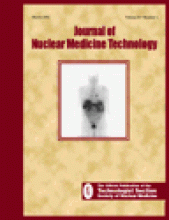
In the December issue, I told you about many of the ideas and projects that were simmering in the minds of members of the Section. I am happy to report that much action took place during the recent Mid-Winter Meeting in Scottsdale, AZ, related to each and every one of the projects previously mentioned.
The SNM-TS grants and awards program was created to support and fund research and education in nuclear medicine technology. The program has been officially named “The Professional Education and Development Fund” and it has been funded by our very first grant, which is from Bristol-Myers Squibb Company in the amount of $10,000. This grant is intended to support some of the data collection we will need to continue our investigation into “the state” of nuclear medicine technology. I am also proud to say that 100% of the Executive Board and the National Council donated to the fund in an impromptu “passing of the hat” during the meetings in Scottsdale. The marketing department has developed a promotional piece for fundraising and presented the Council with a layout to review. We will continue to develop infrastructure for the program in the next few months so that we can present an organizational plan at the Annual Meeting in Los Angeles.
The Scope of Practice for Nuclear Medicine Technologists was approved by the National Council, the Board of Directors, and the House of Delegates of the SNM. It will be published in a future issue of JNMT. The scope document will serve as the template for state licensing after passage of the CARE Act. I heard many compliments on the document from members of the Society. It was held up as a model job description for the technologist.
The subject of entry-level education for nuclear medicine technologists occupied much of the discussion at the National Council Meeting. The discussion led by President-Elect Frances Keech was lively. The Council passed a motion to endorse the concept and continue exploration of the move to a baccalaureate-level entry for all technologists by the year 2010. The task force will look at strategies for bridging programs to accommodate the associate degree programs.
The discussion of an advanced practice model was shorter, but generated the same level of interest. We have discussed this concept for many years, but we are beginning to seriously design a working model. The task force will begin to gather background information over the next few months to answer several questions related to advanced practice. They include surveying the marketplace to determine where this technologist might practice. The lack of nuclear medicine physicians might allow a supervisory technologist to run a community hospital department where the physician is not directly on site. A busy practice in a large hospital might require a technologist who can review films, release patients, and supervise interventional studies. The initial review of the model by the task force indicates that this is a master’s degree level with courses in differential diagnosis, image evaluation, patient assessment, and problem management. Watch for further details to come at the Annual Meeting.







